Do you know?
What is retinol used for?
During World War I, the importance of retinol (derivative of vitamin A) was identified, and later study revealed that its insufficiency causes xerosis and follicular hyperkeratosis. More than two decades ago, retinoids were first used in the treatment of dermatoses, including photoaging.
Retinol is one of the only topical therapies for which solid clinical information about its success in lowering the appearance of aging exists in clinical practice. It has been shown in studies to help with a variety of skin issues, including hyperpigmentation and even acne.
Consecutive aging is an inevitable process, but it increases with more exposure to sunlight, which we call photoaging. Skin, the largest organ in the body, shows the abrupt signs of aging like wrinkles, skin sagging, and fine lines.
To slow down the process of photoaging, one of the best vitamins is a derivative of vitamin A, also called Retinol. Retinol is stored in tissue and other sites of the body like the liver, spleen, lungs, testes, eyes, and skin.
With the increasing interest in slowing down aging, many questions are being asked about what is retinol used for?
Vitamin A (retinol) plays a role in the development and specialization of nearly all cells within the body. Vitamin A has a critical role in embryo development, fetal organ growth, appropriate immune function, and eye development and eyesight.
In this article you will read about retinol, how to use retinol, what does retinol do, retinol benefits, and retinol before and after pores. The article will provide research-based evidence about the impact of topical application of retinol-based cosmetics creams.
What is Retinol?
What is Retinol good for?
Retinol, in generic terms, is a derivative of Vitamin A and can be found as preformed Vitamin A in chicken, meat, eggs, and fish, and as provitamin A in fruits and vegetables.
Aside from its anti-aging properties, what else is retinol used for?
Retinol is good for preventing blindness, which is prevalent in pregnant women and small children.
It acts as a supplement for kids infected with measles over 6 months of age.
To ward off any confusion with retinol and its compounds’ names, as they are all the same, it is important to know that the body may convert retinol to retinal, which can then be oxidized to retinoic acid, a kind of vitamin A that controls transcription of genes. Retinoids are retinol, retinal, retinoic acid, and related compounds. Retinol and retinyl esters are referred to as preformed retinol.
Retinol regulates and prevents major bodily processes such as vision, red blood cell formation, and prenatal and postnatal development. It acts as an anti-infective vitamin to strengthen the immune system.
Women who are 30 or older use retinol in cosmetics as a part of their skin care. Retinol in skin care products provides anti-wrinkle, anti-aging and refines skin texture, which due to aging becomes pale and thin.
What does Retinol do?
Retinol and its compounds have been utilized in medicine for 3000 years, with the liver being used to treat endemic night blindness in ancient Egypt.
Our skin consists of three layers: subcutaneous layers, dermis, and epidermis.
To know how UV light affects the skin tone and leads to hyperpigmentation can be read in the below article. To better understand the present article
https://spreadyourbiz.com/wp-admin/post.php?post=61&action=edit
When applying retinol to the skin layer, when the retinol penetrates the interior of a keratinocyte, it attaches to a specific receptor. There are four types of retinol receptors with high affinity. Keratinocytes, fibroblasts, melanocytes, and Langerhans cells are all stimulated by retinol. Retinol promotes keratinocyte proliferation, strengthens the epidermal protective function, reduces transepidermal water loss, protects collagen from degradation, and inhibits the activity of metalloproteinases that are responsible for extracellular matrix degradation by interacting with receptors inside keratinocytes.
Although retinol’s anti-aging properties are demonstrated by stimulating cell growth, thickening the epidermis, and increasing collagen, retinol may indirectly reduce the skin’s antioxidant properties, leaving it vulnerable to ROS (reactive oxygen damage).Retinol treatment can cause skin symptoms such as redness, dryness, peeling, or burning, which can lead to the discontinuation and withdrawal of retinol by patients.
The term “retinoid” refers to vitamin A equivalents, both synthetic and natural. Retinoids are a group of chemicals that are produced from or have structural and/or functional similarities to vitamin A. Retinoids work on skin in the following way, which is further illustrated in the below figure:
- Retinoids speed up the cell turnover in the skin. To promote new cell growth, old cells are cleared. Retinoid result in a smoother skin texture, a reduction in discoloration by peeling off dark patches, and a reduction in the appearance of pores.
- Retinoids contain anti-inflammatory properties and help to prevent acne by preventing dead skin cells from clogging pores.
Finally, retinoids thicken the skin’s deeper layers. They improve stiffness and reduce lines and wrinkles by stimulating collagen formation and assisting connective tissues in weaving together and becoming denser.
The diagram below will help you understand how retinol reduces the impact of photoaging on skin.
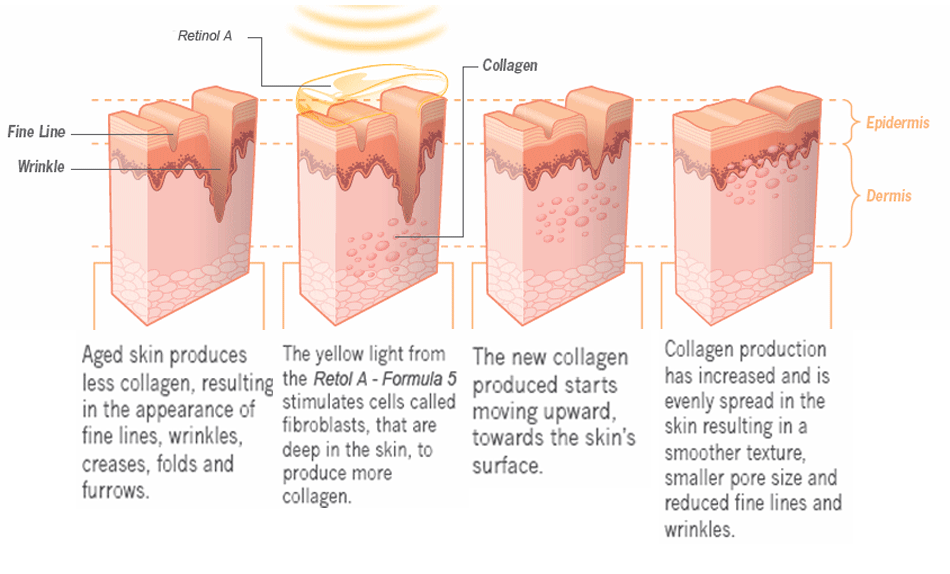
How does retinol and its combination with other products work on the skin?
According to research carried out by researchers on retinoids’ use in cosmetics and dermatology and published in Postepy Dermatol Alergol journal in the National Library of Medicine, the following is the use of retinoids in cosmetics and dermatology.
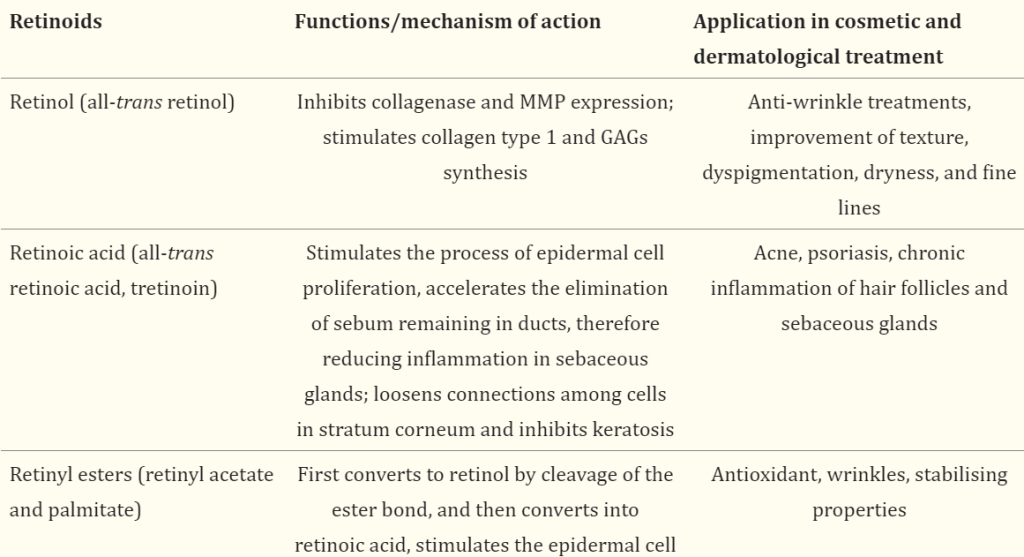
What happens if you use retinol every day?
Should you use retinol every night?
Although retinol has been linked to a reduction in the depth of fine lines and wrinkles, it is also known to irritate the skin, causing erythema, pruritus, peeling, and redness with long-term use. As previously discussed, retinol’s independent actions in the skin include encouraging keratinocyte proliferation, stiffening the epidermis, and increasing collagen (by protecting existing collagen and stimulating new collagen).As mentioned above, like retinoids, retinol when in percentage is combined with other amino acids, antioxidants, and cannabidiol, it has magical impacts on skin.
Retinol before and after pores
Below is the validation of many queries people ask or search for. How do you know if retinol is working?
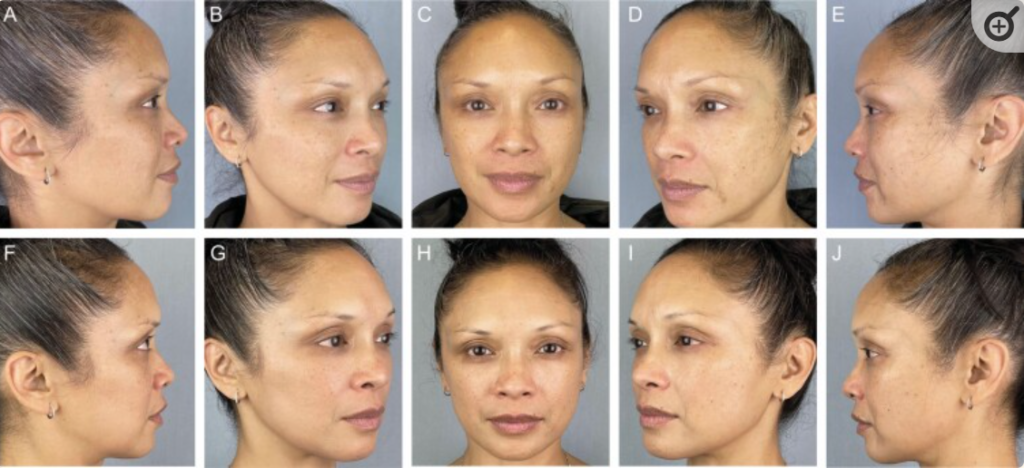
The latest published research on the effects of a novel retinol, peptide, antioxidant, and cannabidiol (CBD) combination on facial skin showed the promising results of the retinol before and after pores on skin in a 53-year-old lady. The application of topical retinol with CBD showed an improvement in her skin. The topical retinol was applied for 42 days at night. The lady’s skin had vertical fine lines on her cheeks and horizontal crow’s feet on either side of her eyes. The 42 night applications of the retinol CBD showed a decrease in the deep fine lines, leaving the skin more hydrated.
Check out the 21-42 days of published research report of the patients’ survey on their experience and clinical outcome as shown in the graph below.
Overall, 100% of patients reported that CR-Topical increased their confidence in their facial appearance.
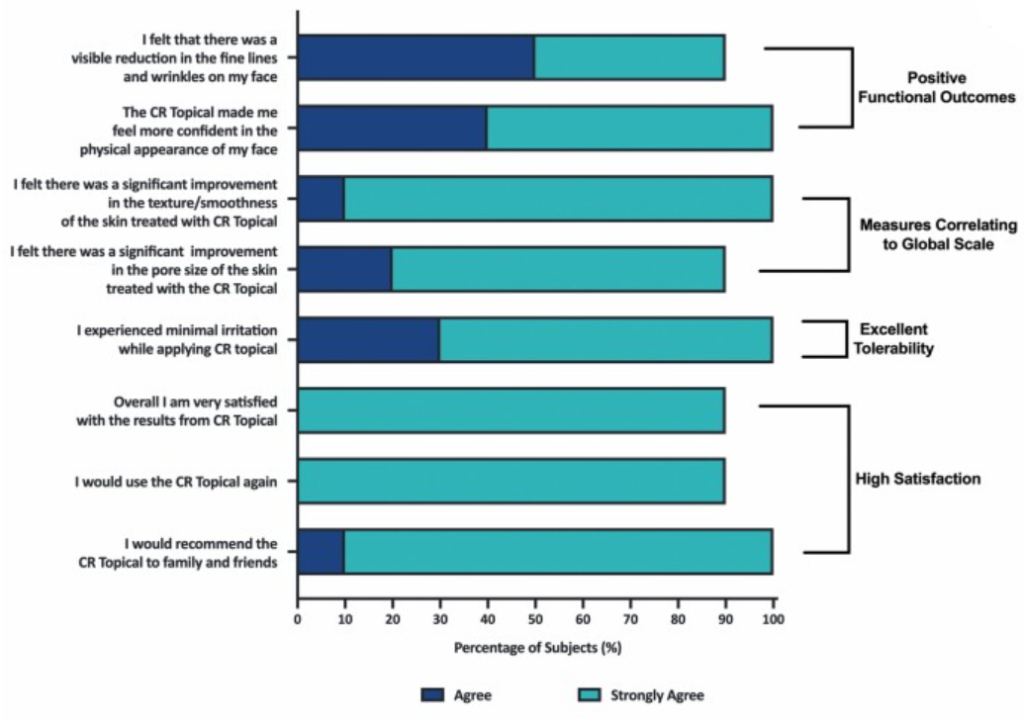
Retinol benefits
- Retinol is a molecule that improves the complexion, dyspigmentation, dryness, and fine lines of the skin.
- Retinol reduces wrinkles and fine lines by smoothing them out.
- It exfoliates dull skin at the cellular level to uncover new skin that is brighter and smoother.
- It controls oily skin and reduces breakouts.
- Diminish over time developed dark age spots, sun spots, and hyperpigmentation, resulting in a more even complexion.
- Retinol is a kind of magic vitamin A that helps to reduce photoaging.
- In cosmeceuticals, retinyl esters such as retinyl acetate and palmitate are often utilized. They are extremely stable, but they must first be transformed into retinol by cleavage of the ester bond, and then into retinoic acid. When compared to retinol and retinoic acid, it has less efficacy in anti-wrinkle features.
What is retinol used for?
Retinol benefits for skin are numerous, but it also has many positive impacts on various body processes discussed above.
- Retinol derivative Retinoid helps reduce acne on the skin.
Retinoids, when applied to the skin, can clear pores, allowing other medicinal creams and gels to operate more effectively. They also prevent dead cells from blocking pores, which helps to avoid acne breakouts. They may minimize the production of acne scars by cleaning acne and minimizing breakouts.
- Tretinoin was the first retinoid to be licensed by the FDA for the treatment of wrinkles.
How do you know if retinol is working?
The prescribed retinoid stimulates the production of new collagen in the body. It also stimulates new blood vessels in the skin, giving it a pink appearance, eliminating age spots, and lowering actinic keratosis, which are precancerous skin lesions. Tretinoin (retinoic acid) is a synthetic vitamin A that may also assist in protecting against the more significant side effects of acne like dark spots, enlarged pores, wrinkles and uneven skin tone.
The below clinical studies carried out on groups of patients will let you know what happens if you apply retinoid and its derivatives and compounds with combination creams for more than 6 months.
Several research groups, like Ellis and colleagues and Green and colleagues, carried out tretinoin treatment on patients for 12 months and noticed a reduction in wrinkles. The clinical indications of photoaging improved significantly after Tretinoin treatment. However, after 6 months, the most significant changes happened. Later on, the changes tend to remain constant. Extending the research for another six months, the application of tretinoin on a weekly or thrice weekly basis yielded more results. Overall, photoaging indications have improved.
- Retinoids are effective at removing warts from the back surface of the hand.
It has been observed that the wart’s cell development is interrupted by retinoid cream.
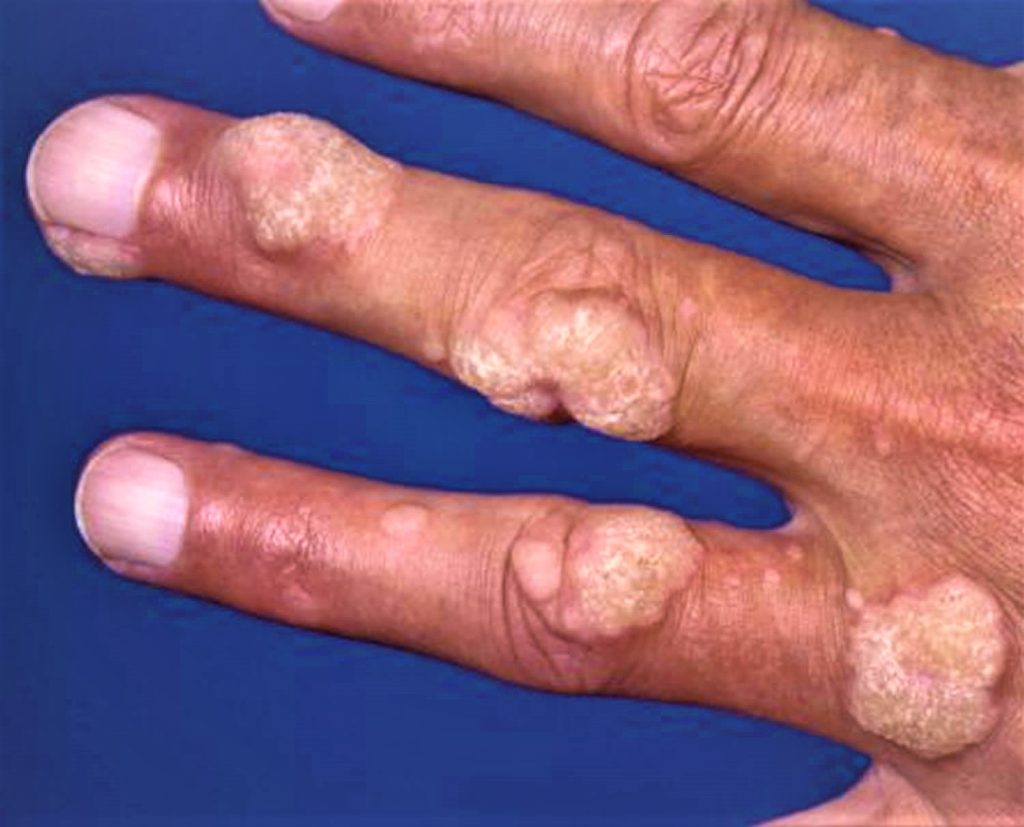
How to use Retinol on skin?
If you’ve chosen to add retinoids to your beauty routine, here are a few things to bear in mind:
- Retinoids are sensitive to light. Retinoids can be rendered inactive by sunlight, so use them at night.
- Retinoids require your skin to adjust. If you start using retinoids every day right away, you’ll likely experience a lot of aggravation. Start with low-concentration retinoids 2-3 times a week and work your way up to using them every day.
- Because retinoids remove the top layer of skin, they make the skin more sensitive to sunlight. When you’re out in the sun, be sure you’ve got SPF applied to your skin.
- Be aware of the negative effects. Retinoids are a type of retinoid that can be drying and irritating. Moderate peeling, redness and irritation are frequent side effects of retinoids, and they might linger for several weeks before your skin adjusts.
Sources
https://www.ncbi.nlm.nih.gov/pmc/articles/PMC6791161/
https://lpi.oregonstate.edu/mic/vitamins/vitamin-A
https://amaci-health.blogspot.com/search?q=retinoids
https://www.ncbi.nlm.nih.gov/pmc/articles/PMC2699641/pdf/cia-1-327.pdf
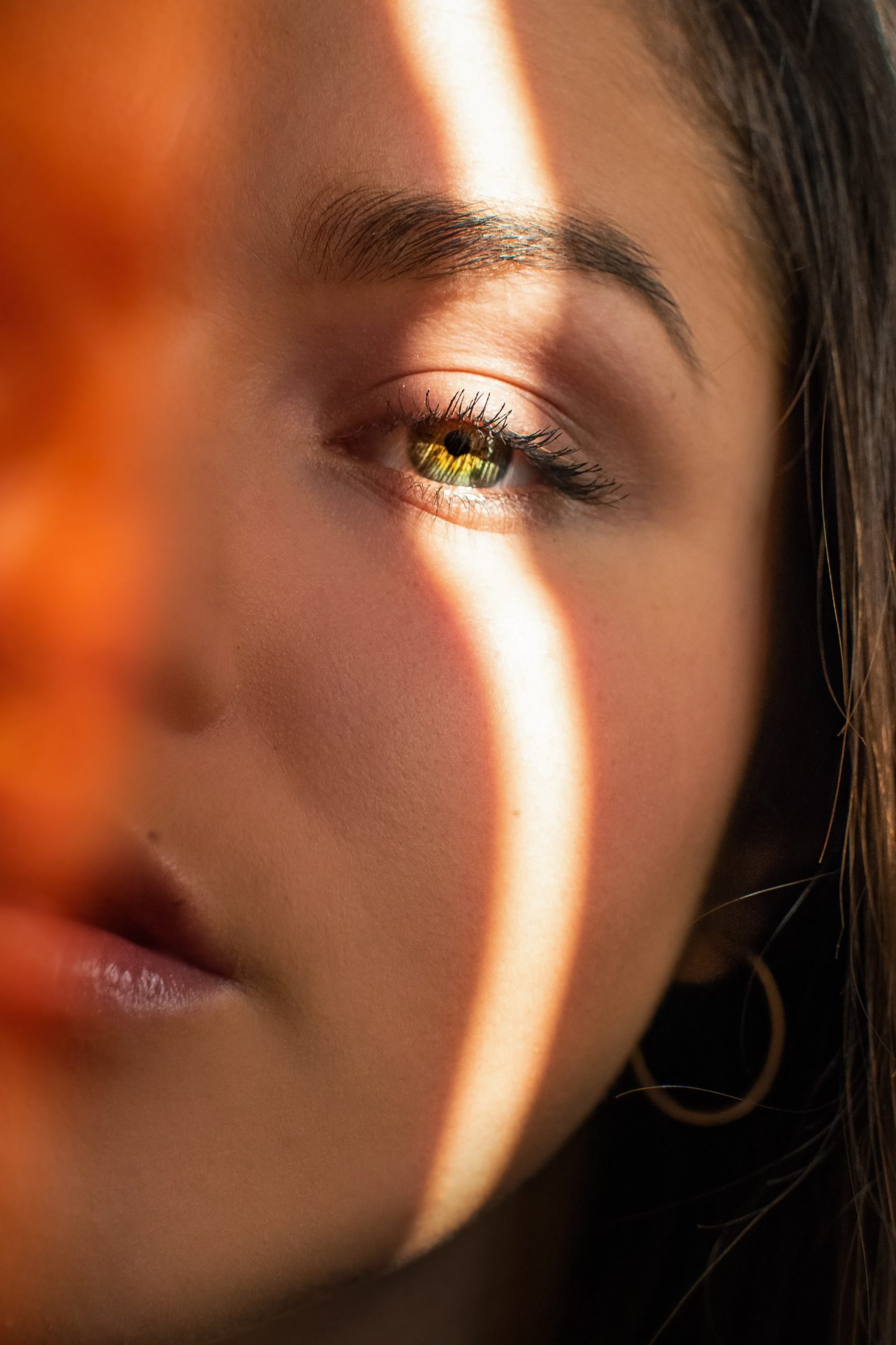
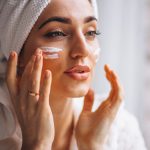

Hi, i feel that i saw you visited my website thus i got here
to go back the favor?.I am trying to in finding issues to enhance my web site!I assume its good enough
to use a few of your concepts!!
Hey there! I simply want to give you a big thumbs up for the excellent information you have here on this post. I am coming back to your website for more soon.
I do agree with all of the concepts you have introduced in your post.
They’re really convincing and will certainly work.
Still, the posts are too short for newbies. May you please extend them a little from
next time? Thanks for the post.